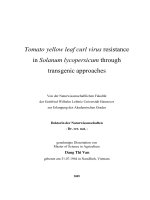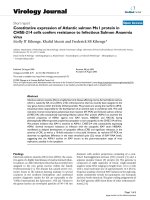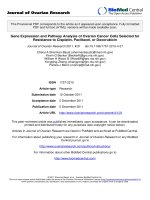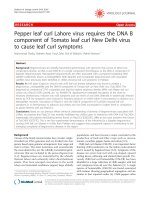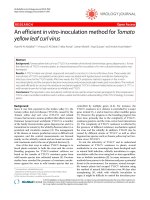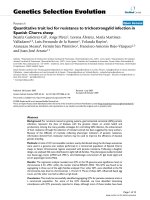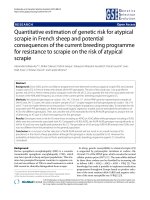Screening of tomato germplasm for resistance to yellow leaf curl virus disease
Bạn đang xem bản rút gọn của tài liệu. Xem và tải ngay bản đầy đủ của tài liệu tại đây (2.01 MB, 65 trang )
VIETNAM NATIONAL UNIVERSITY OF AGRICULTURE
FACULTY OF BIOTECHNOLOGY
--------� � �--------
UNDERGRADUATION THESIS
TITLE:
SCREENING OF TOMATO GERMPLASM FOR
RESISTANCE TO YELLOW LEAF CURL VIRUS
DISEASE
HaNoi, 2022
VIETNAM NATIONAL UNIVERSITY OF AGRICULTURE
FACULTY OF BIOTECHNOLOGY
--------� � �--------
UNDERGRADUATION THESIS
TITLE:
SCREENING OF TOMATO GERMPLASM FOR
RESISTANCE TO YELLOW LEAF CURL VIRUS
DISEASE
Student name
: Nguyen Thi Ngoc Anh
Student code
: 620659
Class
: K62CNSHE
Supervisor
: Prof. Ph.D. PhanHuu Ton
Research location
Center for Conservation and
: Development of Crop Genetic
Resources (CCD-CGR)
HaNoi, 2022
COMMITMENT
I hereby declare that the data and research results in this thesis are true and
do not copy the results of any previous graduate reports. Graduation thesis with
references to documents, citation information is indicated in the references
section.
Hanoi, March 15th, 2022
Sincerely,
Nguyen Thi Ngoc Anh
i
AKNOWLEDGEMENTS
First of all, with the deepest and most sincere affection, allow me to
express my gratitude to Prof. Ph.D. PhanHuu Ton, who enthusiastically guided
and taught me valuable professional knowledge and lessons during the process
of completing my undergraduation thesis. Besides, I would also like to thank the
masters and engineers PhanThanh Tung, PhanHuu Hien and PhamDinh On who
are working at the Center for Conservation and Development of Crop Genetic
Resources, for helping and creating the most favorable conditions for me in the
process internship at the center.
Second, I would like to express my deep gratitude to all the individuals and
organizations that have facilitated and supported me throughout the process of
studying and researching. In order to successfully complete this undergraduation
thesis, in addition to my own efforts, I also received a lot of attention and
support from teachers, friends as well as family members.
Third, I would like to express my deepest gratitude to the teachers of the
Faculty of Biotechnology-Vietnam National University of Agriculture. With the
understanding and dedication of the teachers, they have imparted to me a lot of
valuable knowledge during my 4 years of studying at the school so that I can
equip myself with the necessary knowledge to be able to successfully complete
the undergraduation thesis.
Finally, I would like to thank my parents and loved ones for their love and
support so that I can successfully complete this undergraduation thesis. I would
like to convey to them my deep gratitude.
Hanoi, March 15th, 2022
Sincerely,
Nguyen Thi Ngoc Anh
ii
CONTENTS
COMMITMENT .................................................................................................. i
AKNOWLEDGEMENTS................................................................................... ii
CONTENTS ........................................................................................................ iii
LIST OF TABLES .............................................................................................. v
LIST OF FIGURES ........................................................................................... vi
LIST OF ABBREVIATIONS........................................................................... vii
Part 1. INTRODUCTION .................................................................................. 1
1.1. Introduction ................................................................................................... 1
1.2. Aim and request ............................................................................................ 2
1.2.1. Aim.............................................................................................................. 2
1.2.2. Request ........................................................................................................ 2
Part 2. LITERATURE REVIEW ...................................................................... 3
2.1. Overview of tomato....................................................................................... 3
2.1.1. Origins of tomato ........................................................................................ 3
2.2. Tomato yellow leaf curl virus (TYLCV) ...................................................... 7
2.2.2. Distinguishing tomato yellow leaf curl virus (TYLCV) from other
conditions .................................................................................................... 7
2.2.3. Resistance genes to tomato yellow leaf curl virus (TYLCV) ..................... 9
Part 3. MATERIAL, CONTENT AND METHOD ....................................... 23
3.1. Material ....................................................................................................... 23
3.2. Time and research schedule ......................................................................... 24
3.3. Research contents ........................................................................................ 24
3.4. Method......................................................................................................... 24
3.4.1. Experiment ................................................................................................ 24
3.4.2. Evaluation of agronomy biological characteristics, yield potention and
quality of fruit ........................................................................................... 24
iii
3.4.3. Evaluation of resistance to tomato yellow leaf curl virus of screening
tomato varieties ......................................................................................... 26
3.4.3.1. Detection of resistance gene to yellow leaf curl virus Ty2 and Ty3 by
PCR........... ................................................................................................ 26
3.4.3.2. Artificial infection ................................................................................. 28
Part 4. RESULTS AND DISCUSSION ........................................................... 30
4.1. Results of evaluation of some agro-biological characteristics .................... 30
4.1.1. Time to complete the growth and development stages............................. 30
4.1.2. Structural, morphological of plant ............................................................ 31
4.1.3. Yield and its componentelements ............................................................. 34
4.1.4. Fruit quality ............................................................................................... 37
4.2. Results of PCR method to select Ty2 and Ty3 genes .................................. 38
4.2.1. Results of total DNA extraction................................................................ 38
4.2.2. Results of PCR to detect Ty2 and Ty3 genes ............................................ 39
4.2.2.1. Results of PCR to detect Ty2 ................................................................ 39
4.2.2.2. Results of PCR to detect Ty3 ................................................................ 42
4.3. Results of artificial infection ....................................................................... 45
Part 5. CONCLUSION ..................................................................................... 48
REFERENCES .................................................................................................. 49
iv
LIST OF TABLES
Table 2.1. List of disease and disorder symptoms similar to TYLCV (Walker
2006). ............................................................................................................. 8
Table 2.2. Tomato (Solanum lycopersicum) wild relatives as resistance sources
for tomato yellow leaf curl disease.............................................................. 14
Table 4.1. Growth stage of tomato. ..................................................................... 30
Table 4.2. Structural, morphological of tomatoes.............................................. 31
Table 4.3. Morphological of fruit. ....................................................................... 33
Table 4.4. Yield and its component elements. .................................................... 35
Table 4.5. Fruit quality. ....................................................................................... 37
Table 4.6. Characterization of some high yield and high quality varieties
compared to control varieties. ..................................................................... 38
Table 4.7. Result of PCR to detect resistance gene Ty2. .................................... 41
Table 4.8. Result of PCR to detect resistance gene Ty3. .................................... 44
Table 4.9. Result of evaluation of the resistance level of each varieties by
artificial infection. ....................................................................................... 47
Table 5.1. Evaluation of good varieties. ............................................................. 48
v
LIST OF FIGURES
Figure 2.1. Tomato fruit ripening process at the cell level. .................................. 5
Figure 2.2. Ty1 expression is elevated in resistant lines. .................................... 11
Figure 2.3. Schematic representation of the region of interest of chromosome 6.
................................................................................................................... 16
Figure 2.4. Representation of single nucleotide polymorphism (SNP) and indel
information for Ty4 closely-linked markers. ............................................ 20
Figure 2.5. SNP information for ty5 (Pelota) gene-based marker development. 21
Figure 3.1. Expression levels of tomato yellow leaf curl disease infected by
TYLCV (Lapidot and Friedmann, 2002). ................................................. 29
Figure 4.1. Total DNA of 32 tomato varieties studied. ...................................... 39
Figure 4.2. Electrophoresis of PCR products using primer set T0302F/TY2R1 to
detect resistance gene Ty2 (lane 1-32). ..................................................... 40
Figure 4.3. Electrophoresis of PCR products using primer set P6-25-F2/P6-25R5 to detect resistance gene Ty3 (lane 1-32). ........................................... 43
Figure 4.4. Varieties after 40 days of grafting diseased plants. .......................... 46
Figure 5.1. Two varieties with high yield, good quality, and the ability to carry
resistance genes. ........................................................................................ 48
vi
LIST OF ABBREVIATIONS
CTAB : Cetyltrimethylammonium bromide
DNA
: Deoxyribonucleic acid
EDTA : Ethylene Diamine Tetraacetic Axit
PCR
: Polymerase chain reaction
SCAR : Sequence characterized amplified regions
SNP
: Single nucleotide polymorphism
TYLCV : Tomato yellow leaf curl virus
vii
Part 1. INTRODUCTION
1.1. Introduction
Tomato (Solanum lycopersicum L.) is an important fruit vegetable in our
country. It belongs to the family Solanaceae, which includes several other
commercially important species. Tomato is grown worldwide for local use or as
an export crop. Tomato has very few competitors in the value addition chain of
processing.
For tomatoes, yellow leaf curl virus causes the most severe effects. Tomato
yellow leaf curl virus (TYLCV) is caused by several viruses belonging to the
genus Begomovirus, family Geminiviridae, first detected in Israel in 1939 (Píco
et al., 1996). This disease causes serious damage to the yield and quality of
tomatoes. Yield losses average from 55 - 90%, even 100% when the plant is
severely infected with this disease (Reynaud et al., 2003). TYLCV is spread by
the whitefly Bemisia tabaci, which is a fast-reproducing insect that is very
difficult to control. Pandemics caused by their outbreaks have been recorded.
Much effort has been focused on identifying sources of disease resistance by
screening wild tomato varieties.
Currently, there is no effective pesticide to prevent this disease, if infected
plants should only be uprooted. Therefore, using disease resistant tomato
varieties is the most effective measure. Disease resistant tomato varieties are not
only significant for improving yield and quality, but are also safe for human
health, domestic animal and the environment (Phan Huu Ton et al., 2013).
To successfully develop tomato varieties resistant to yellow leaf curl virus,
the first thing to do is to determine the number of resistance genes (Phan Huu
Ton et al., 2013). Up till now, scientists around the world have identified 5
different resistance genes to tomato yellow leaf curl virus.
DNA markers
associated with yellow leaf curl resistance genes Ty1, Ty2, Ty3, Ty4 and ty5 have
1
also been published (Pérez de Castro et al., 2007; Garcia et al., 2007; Ji et al.,
2007; Ji et al., 2009; Zhang., 2010 và Lapidot et al., 2015), which makes resistance
gene detection and breeding for resistance more convenient and quick.
To create tomato varieties resistant to yellow leaf curl virus, it is necessary
to evaluate the tomatoes germplasm, so conducting artificial infection.
Currently, with the development of biology, people use molecular markers to get
more exactly results.
Therefore, under the guidance of Prof. Ph.D. Phan Huu Ton, we conducted
the research title “Screening of Tomato Germplasm for Resistance to Yellow
Leaf Curl Virus Disease”.
1.2. Aim and request
1.2.1. Aim
Evaluation of agro-biological characteristics, yield potential, fruit quality
and resistance to yellow leaf curl virus of the tomato germplasm.
1.2.2. Request
Evaluation of some agro-biological characteristics, yield potential and fruit
quality in winter-spring crop.
Evaluation of genes for resistance to tomato yellow leaf curl virus using
DNA assisted markers and artificial infection.
2
Part 2. LITERATURE REVIEW
2.1. Overview of tomato
2.1.1. Origins of tomato
Tomato (Solanum Lycopersicum) is ranks as the second most important
vegetable crop after potato in the world. (Cherono and Workneh, 2018, Mujtaba
and Masud, 2014, and Pinheiro et al., 2015). Egypt considers one of the top
most tomato growing countries and ranks as the fifth largest producer country in
the world accounting for more than 4.0% of the global tomato production.
According to the latest statistical statement (FAO STAT, 2019); the area
cultivated with tomatoes in Egypt is around 450,000 acres with a production of
7.297.108 tons at the year 2017.
Tomato is one of the most popular vegetable that consumed as fresh or
processed products and represents an important source of several valuable
nutrients and non-nutrients components. Tomato is considered as part of healthy
diet regime as they are low in fats and are without any harmful cholesterol.
Nutrients like vitamins (A, C and E), minerals (K, Mn, Ca, Cu and Zn), and
folate are present in significant concentrations in tomatoes (Chaudhary et al.,
2018 and Tan et al., 2010).
Tomatoes also contain significant amounts of several phytochemicals that
are identified as functional compounds such as vitamin C, carotenoids
(lycopene, phytoene, and β-carotene), flavonoids and polyphenolic compounds
(CaneneAdams et al., 2005, Chaudhary et al., 2018 and Tan et al., 2010). The
functional compounds are healthy benefit compounds that reduce the risk of
specific diseases or other health concerns. The functional compounds are
defined as bioactive non-nutritive compounds that may provide desirable
healthy benefits beyond basic nutrition to reduce the risk of major chronic
3
diseases (Liu 2004). High consumption of fruits and vegetable, including tomato
and its derivatives, has great positive benefits on consumer health.
Tomatoes are processed into several products included; juice, sauce, paste,
ketchup, soup, canned tomato, and dehydrated tomato as slices or powder
(Capanoglu et al., 2008, Beckles, 2012, Mujtaba and Masud, 2014, Pinheiro et
al., 2015). Among these products; tomato paste is one of the most important
consumption products worldwide. The quality characteristics of the processed
tomato products are mainly judged by their good sensory attributes and high
nutritional value (Cadas-López et al., 2018 and Xaplanteris et al., 2012).
Agriculture and food processing sectors are closely connected industries in the
food system structure. Agriculture is the industry that supplies the major raw
materials with good quality for the food industry. The high consumption of
tomatoes as fresh fruits and processed tomato products resulted in the
development of agricultural operations with the aim of increasing production
yield and improving quality characteristics. Among the agricultural factors
included; weather conditions, production systems, irrigation, cultivars, ripening
stage and harvest time; fertilization is one of the most important factors that
affect chemical composition quality in tomato production. The commercially
available fertilizers supply the essential elements in a variety of chemical forms.
Numerous mineral fertilizers have been developed to supplement soil nutrients
and to meet the high requirements of crops. They are generally mineral salts,
except for some organic chemicals such as urea, which are easily converted into
salts (Mani, 2017). The advantages of the commercial fertilizers are their high
water solubility, immediate availability to the plants, high concentration of
nutrients, and the uniformity and accuracy with which specific amounts of
available nutrients can be applied (Mani, 2017, Sugiyanto, 2011, Vaneeckhaute
et al., 2013).
Humic materials are composed of complicated organic mixtures which are
linked together in a random manner, resulting in complex materials. Humic acid
4
is a natural acidic organic polymer that can be extracted from humus found in
soil, sediment, or aquatic environments (Alvarez-Puebla et al., 2005, Selim et
al., 2014, and Saiz-Jimenez, 1996). The fertilizer potassium humate (Khumate)
is a natural material that can improve soil physical and chemical properties and
nutrient dynamics (Kumar et al., 2013; Abd-All et al., 2017).
Tomato is a climacteric fruit, having respiratory peak during their ripening
process (Figure 2.1). Being a climacteric and perishable vegetable, tomatoes
have a very short life span usually 2-3 weeks. It is one of the most popular
vegetable grown in Pakistan and is widely used in salad as well as for culinary
purposes. Red ripe tomatoes are used as flavoring agent in the preparation of
various home made food dishes to increase the palatability. Tomato is usually
used for the manufacturing of various byproducts such as tomato ketchups,
sauces, purees, jellies, soups and pastes. It contains a significant amount of
vitamin A and C.
Figure 2.1. Tomato fruit ripening process at the cell level.
5
High quality tomatoes have a firm, uniform and shiny color, good
appearance, without signs of mechanical injuries, shriveling and bruise. The
major causes of post harvest losses are decay of fruit, external injury during
harvesting, handling and storage of tomato fruits. In addition, environmental
factors such as soil type, temperature, frost and rainy weather during harvest can
cause severe effect on storage life and quality of tomatoes (Bachmann and
Earles, 2000). Temperature plays a key role in the metabolism of fruits and
vegetables (Marangoniet al., 1996). Number of chemical and physical processes
takes place in vegetables during shelf storage. Water comprises 90% of the fresh
weight of tomato fruit and the size of the fruit is influenced by the availability of
water to the plant. The large amount of water also makes the fruit perishable.
Citric acid is the main acid in tomato juice and the pH of fruit is normally 4.0 to
4.5. The pH of the fruit increases throughout development (Padmini, 2006).
Also, quality of most fruits and vegetables is affected by water loss during
storage, which depends on the temperature and relative humidity conditions
(Perez et al., 2003).
The rapid quality loss at relatively short period of 4-7 days is an efficient
means of storing the fruits to reduce post harvest losses and improve the quality
and acceptability in the consumer market (Thompson et al., 1998). This needs to
develop technology for extending the storage life from the point of production to
the point of consumption. Packaging can markedly extend the storage life of
many fresh fruits and vegetables through the inhibition of physiological
deterioration and reducing weight loss (Shetty et al., 1989 and Risse et al.,
1985). Packaging can create modified gas atmospheres around the product
which slows down the respiratory activity of tomato. Sealing of tomatoes in
polyethylene film packages extended the length of time until ripening (Hobson,
1982). Weight loss in wrapped tomato was significantly decreased and fruits
were more firm than non wrapped tomatoes (Shetty et al., 1989 and Risse et al.,
1985). It had been found that the best storage temperature for delaying ripening
6
of tomatoes fruits is 12.7oC (Parsons et al., 1994). Previous work by the
investigator (Al-Mughrabi, 1989) proved that storage at 25oC was preferable for
good red color of tomato fruits. Keeping in view the above facts the present
study was designed to evaluate the effect of wrapping materials on the quality
characteristics of tomatoes during ripening at different temperatures.
2.2. Tomato yellow leaf curl virus (TYLCV)
Tomato yellow leaf curl disease (TYLCD) has been a global constraint to
tomato (Solanum lycopersicum) production since the 1980s (Moriones and
NavasCastillo, 2000). Up till now, TYLCD is still one of the most devastating
diseases of tomato. Infected susceptible tomato plants show symptoms that
include yellowing, curling, and cupping of leaves, severe stunting and abortion
of flowers and fruits, all of which can lead to yield reduction of up to 100%
(Abhary et al., 2007). TYLCD can be caused by a cluster of related virus species
including tomato yellow leaf curl virus (TYLCV), which belongs to the genus
Begomovirus of the Geminiviridae family. TYLCV has a wide host range that
includes tomato (S. lycopersicum), sweet pepper (Capsicum annuum), chili
pepper (C. chinense), tobacco (Nicotiana tabacum), common bean (Phaseolus
vulgaris), petunia (Petunia × hybrida), and lisianthus (Eustoma grandiflora)
(Díaz-Pendón et al., 2010).
2.2.2. Distinguishing tomato yellow leaf curl virus (TYLCV) from other
conditions
TYLCV can be confused with other diseases and disorders.
7
Table 2.1. List of disease and disorder symptoms similar to TYLCV
(Walker 2006).
Disease or
Symptom description
dissorder
Tomato big bud
Produces big buds and green flowers
Tomato yellow top Leaflets are reduced in size and rounded with yellowish down-curled
virus
or up-curled margins
Physiological leaf Young expanding leaves are soft, not rigid and stunting is absent
roll (water stress)
Phosphate
Purplish tinge to whole plant, stiff and stunted plants
deficiency
Magnesium
Interveinal yellowing of middle and lower leaves
deficiency
Tomato yellow leaf curl virus (TYLCV) is a virus species causing
epidemics in tomato (Solanum lycopersicum) worldwide. Many efforts have
been focused on identification of resistance sources by screening wild tomato
species. In many cases, the accession numbers were either not provided in
publications or not provided in a consistent manner, which led to redundant
screenings. In the current study, they summarized efforts on the screenings of
wild tomato species for TYLCV resistance from various publications. In
addition, they screened 708 accessions from 13 wild tomato species using
different inoculation assays (i.e., whitefly natural infection and Agrobacteriummediated inoculation) from which 138 accessions exhibited no tomato yellow
leaf curl disease (TYLCD) symptoms. These symptomless accessions include 14
accessions from S. arcanum, 43 from S. chilense, 1 from S. chmielewskii, 28
from S. corneliomulleri, 5 from S. habrochaites, 4 from S. huaylasense, 2
from S. neorickii, 1 from S. pennellii, 39 from S. peruvianum, and 1 from S.
pimpinellifolium. Most of the screened S. chilense accessions remained
symptomless. Many symptomless accessions were also identified in S.
8
arcanum, S. corneliomulleri, and S. peruvianum. A large number of S.
pimpinellifolium accessions were screened. However, almost all of the tested
accessions showed TYLCD symptoms.
2.2.3. Resistance genes to tomato yellow leaf curl virus (TYLCV)
In nature, TYLCV is transmitted exclusively by the sweet potato whitefly
Bemisia tabaci (Genn.) in a persistentcirculative manner (Gronenborn, 2007). B.
tabaci is an invasive pest with global importance since more than 175 countries
officially report the presence of B. tabaci (CABI 2017; Bemisia tabaci. In:
Invasive Species Compendium1). B. tabaci is a complex consisting of at least 24
distinct species (De Barro et al., 2011). The Bemisia Middle EastAsia Minor 1
(MEAM1/B) and Mediterranean (MED/Q) are regarded as the most invasive and
damaging species, and these are also the species that transmit TYLCV to tomato
(De Barro et al., 2011; Ning et al., 2015). Serious damage in tomato production
attributed to TYLCV was first reported in Israel in 1959 (Cohen and Antignus,
1994). Since then, the list of tomato production regions reporting TYLCV
epidemics has grown (Barboza et al., 2014; Chinnaraja et al., 2016; Mabvakure
et al., 2016). Among the countries for which B. tabaci incidence was reported,
more than 70 also reported the occurrence of TYLCV [CABI 2016; TYLCV
(leaf curl). In: Invasive Species Compendium2 ].
Domesticated tomato is known to be vulnerable to TYLCV infection, but
resistance exists in wild tomato species (Ji et al., 2007b). Accessions exhibiting
no TYLCD symptoms upon infection have been reported in a number of species,
including S. arcanum, S. cheesmaniae, S. chilense, S. chmielewskii, S.
corneliomulleri, S. galapagense, S. habrochaites, S. neorickii, S. pennellii, S.
peruvianum, and S. pimpinellifolium (Ji et al., 2007b; Vidavski et al., 2008; De
la Peña et al., 2010; Pereira Carvalho et al., 2010; Tomás et al., 2011). So far,
three TYLCV resistance genes have been cloned. Ty1 and Ty3 originate from S.
chilense accession LA1969 and LA2779, respectively (Zamir et al., 1994; Ji et
al., 2007a). They are two alleles of the same gene that is located on the long arm
9
of tomato chromosome 6 and encodes an RNA dependent RNA polymerase
(RDR) (Verlaan et al., 2011, 2013). Ty2, originating from S. habrochaites
accession B6013 and located on the long arm of chromosome 11, encodes an
NB-LRR gene (Yang et al., 2014; Yamaguchi et al., 2018). ty5 is a
lossoffunction mutant allele of the pelota gene located on chromosome 4. The
mutation in ty5 is caused by a T-to-G transversion in the coding region, which
occured in cultivated tomato (Lapidot et al., 2015). However, it has also been
suggested that ty5 is derived from a complex of S. peruvianum accessions
(Anbinder et al., 2009). In addition to these cloned genes, two resistance loci
Ty4 and Ty6 have been mapped. Ty4 is identified from S. chilense LA1932. This
locus is located on the long arm of chromosome 3 and has a minor effect toward
TYLCV resistance (Ji et al., 2009). Ty6 is the most recently identified TYLCV
resistance locus on the long arm of chromosome 10, presumably originating
from S. chilense accessions LA1938 and LA2779 (Hutton and Scott, 2014). Up
till now, introgressions of Ty1, Ty2, and Ty3 into cultivated tomato have been
the major focus in breeding programs. Ty2 based resistance can be overcome by
TYLCV related Tomato yellow leaf curl Sardinia virus (TYLCSV) (Barbieri et
al., 2010) and breakdown of Ty2 mediated resistance has been demonstrated
recently by an isolate of the Mild strain of TYLCV (TYLCV-Mld) (Ohnishi et
al., 2016). Ty1-mediated resistance is not suitable to use under high disease
pressure which leads to resistance breakage in some cases (García -Cano et al.,
2008). Resistance breakage facilitates TYLCD epidemics, which urges plant
breeders to continuously search for effective novel sources of resistance in the
wild tomato gene pool. In multiple research programs wild tomato germplasm
has been screened in order to identify accessions that can be utilized as sources
of TYLCV resistance. Although these efforts have resulted in the identification
of a number of sources exhibiting no TYLCD symptoms, the accession numbers
of these sources were not consistently provided in publications, which led to
redundant screenings in some cases. In addition, they reported the identification
of 138 tomato accessions that were TYLCD symptomless in a largescale
screening of 708 accessions from 13 wild tomato species. Finally,
10
they
discussed the potential use of the newly identified resources for TYLCV
resistance in tomato breeding, in the context of donor species, the cloned Ty
genes and viral titer levels.
a) Ty1
Ty1 is relatively high expressed.
Considering a potential role of the Ty1 encoded RDR in mounting a strong
antiviral RNAi response, its transcriptional expression level was analyzed. To
this end, a time-series experiment was performed during which expression of the
resistant Ty1 and the susceptible ty1 allele was quantified upon TYLCVchallenge via agroinoculation in both tomato lines. The expression level of the
specific allele was measured by qPCR at several time points (Figure 2.2). The
results showed that at all time points the basic transcription level of
the Ty1 allele was significantly higher compared to the ty1 allele. In the
resistance line, no significant difference was observed for the Ty1 expression
between mock and TYLCV inoculated plants at all time points. However, in the
susceptible Moneymaker line, the expression of the ty1 allele was induced upon
TYLCV inoculation at 12 and 19 days. Compared with day 0 of resistant and
susceptible lines, the respective expression of Ty1 and ty1 was decreased at day
5 and increased at day 19.
Figure 2.2. Ty1 expression is elevated in resistant lines.
Normalized
fold
in
gene
expression
of
the ty1 (susceptible)
and Ty1 (resistant) allele. Numbers below x-axis indicate days after inoculation.
Values are normalized against the Moneymaker day 0 sample, bars represent
11
means and standard deviation of five biological replicas. Asterisks under the xaxis represent significant differences to the Moneymaker day 0 sample, asterisks
above the bars represent significant differences between Mock or TYLCV
treatment. (* = P<0.05, ** = P<0.01, *** = P<0.001, ns = not significant).
For
fine-mapping Ty1 from S.
chilense accession
LA1969,
a
TYLCVresistant commercial hybrid Tygress with an introgression between
markers Mi23 and P6-25, reflecting the same interval as described by Verlaan et
al. (2011), was used. This Ty1 introgression was done by Jaap Hoogstraten of
the
Royal
Sluis
Seed
Company,
and
it
is
different
from
the
LA1969 Ty1 introgression that was done in Israel. This hybrid was selfpollinated to produce F2 progeny. Through two cycles of selection for
recombination in this F2 population, two recombinants were identified and used
to generate RILs by selfing and selection with marker genotyping for
homozygous introgressions. The first recombination event resulted in a resistant
RIL containing a S. chilense introgression flanked by markers Mi23 and
HBa0045I03
and
was
used
as
a
control
(named
as Ty1 RIL)
in
all Ty1 experiments. Another recombination event resulted in a resistant RIL
containing a S. chilense introgression between markers T0774 and HBa0045I03.
The susceptible Fla. 7776 was crossed to this inbred and an F2 population was
generated. Approximately 2000 F2 plants were screened for recombination
between the markers T0774 and SL_2.40ch06_30.891 and 13 recombinants
were identified. These recombinants were selfed to develop F4 RILs as described
before. RILs were evaluated, along with the controls Fla. 7776, Tygress and
the Ty1 RIL in fall 2011. Four week-old seedlings were inoculated with TYLCV
for 11 days then transplanted to the field on 4 October in a non-randomized trial
with two replications of 4 plant plots. TYLCV disease severity was evaluated on
each plant 6 weeks after exposure to whiteflies.
To produce durable and broadspectrum resistance, an essential approach
would be to use multiple genes, a process known as pyramiding/stacking.
12
Desirably, the stacked genes should confer different types of resistance. The
chance of viruses overcoming polygenic resistance is substantially reduced
compared to monogenic resistance. It requires a virus to accumulate various
mutations with a low incidence and probably a fitness cost to adapt to
pyramided resistance genes which is not likely to occur. In light of the
effectivity of the Ty1 gene against a broad spectrum of DNA viruses,
pyramiding distinct gene(s) including Ty1 offers one possibility to achieve the
goal. Such efforts in tomato have been shown to lead to enhanced resistance
relative to the level in the presence of single genes.
In light of this, transcriptional expression analysis of Ty1 showed elevated
expression levels in resistant lines compared to those in susceptible lines, even
without TYLCV challenging. Whether differences in the Ty1 and ty1 protein or
just those in transcriptional expression levels, or even a combination of both, are
the cause of resistance remains to be investigated. However, since they did not
observe hyper-susceptibility in tomato Moneymaker after silencing of the
susceptible allele, as what is observed for Potato Virus X (PVX) and potato
potyvirus Y (PVY) after silencing of Nicotiana benthamiana RDR6, a function
of ty1 in resistance is highly unlikely. The functionality and transcriptional
upregulation of Ty1 thus seems the most plausible reason to explain the
resistance. To solve this issue, transgenic tomato lines (over) expressing either
the resistant allele or the susceptible allele will be made. Analysis of the
expression level and protein sequence of Ty1/ty1 in other resistant/susceptible
tomato varieties and wild species will additionally be informative and
experiments for these are currently being prepared.
b) Ty2
Ty2 was first reported in a tomato line H24 derived from S. habrochaites
accession B6013 and was mapped on the long arm of chromosome 11 (Table
2.2). Finemapping of the Ty2 gene was a great challenge due to a chromosomal
inversion present in S. habrochaites compared with S. lycopersicum, resulting in
13
suppression of chromosome recombination. By using intraspecific crosses
between two S. habrochaites accessions, suppression of recombination in the
Ty2 region was overcome, allowing the finemapping of the Ty2 gene. Ty2 was
shown to encode a nucleotidebinding leucine rich repeat protein (NLR). The
Rep/C1 protein of TYLCV presents the Avr determinant of Ty2 based
resistance.
Table 2.2. Tomato (Solanum lycopersicum) wild relatives as resistance
sources for tomato yellow leaf curl disease.
a
Bold font indicates cloned genes; b Tyking, the source of the ty5 gene, is an old
tomato cultivar; c RDR = RNA-dependent RNA polymerase; NLR = nucleotide
binding leucine-rich repeat protein; Pelota = Message RNA Surveillance Factor
Pelota.
Resistances to begomoviruses, including bipartite tomato mottle virus and
monopartite tomato yellow leaf curl virus (TYLCV), have been introgressed to
cultivated tomato (Solanum lycopersicum) from wild tomato accessions. A
major gene, Ty2 from S. habrochaites f. glabratum accession “B6013,” that
confers resistance to TYLCV was previously mapped to a 19cM region on the
long arm of chromosome 11. In the present study, approximately 11,000 plants
were screened and nearly 157 recombination events were identified between the
flanking markers C2_At1g07960 (82.5 cM, physical distance 51.387 Mb) and
T0302 (89 cM, 51.878 Mb). Molecular marker analysis of recombinants and
TYLCV evaluation of progeny from these recombinants localized Ty2 to an
14
approximately 300,000bp interval between markers UP8 (51.344 Mb) and M1
(51.645 Mb).
No
recombinants
were
identified
between
TG36
and
C2_At3g52090, a region of at least 115 kb, indicating severe recombination
suppression in this region. Due to the small interval, fluorescence in situ
hybridization analysis failed to clarify whether recombination suppression is
caused by chromosomal rearrangements. Candidate genes predicted based on
tomato genome annotation were analyzed by RT-PCR and virus-induced gene
silencing. Results indicate that the NBS gene family present in the Ty2 region is
likely not responsible for the Ty2-conferred resistance and that two candidate
genes might play a role in the Ty2-conferred resistance. Several markers very
tightly linked to the Ty2 locus are presented and useful for marker-assisted
selection in breeding programs to introgress Ty2 for begomovirus resistance.
Identification of the specific interactions between the proteins encoded by
TYLCV (wild or mutants) and the proteins encoded by the Ty-gene alleles, as
was done for the Microorganisms 2021, 9, 740, 13 of 19 Ty2 gene. This will
allow us to forecast the effectiveness and durability of the Ty-genes in different
tomato production areas by monitoring viral variants in the population.
c) Ty3
The Ty3 gene was previously mapped between T0774 and T1079. By
screening an F2 population (n = 717) from a cross between the susceptible line
Fla. 7781 with the resistant line Fla. 8680 (carrying the Ty3 introgression
from S. chilense LA2779), 30 recombinants were identified. RILs of these
recombinants were generated and tested with TYLC. To further narrow down
the Ty3 interval, RILs of two key recombinants were used to generate three
F2 sub-populations, A, B and C. Screening more than 10,500 individuals of
these sub-populations with markers Mi23 and P6-25 (sub-population A and B)
and markers T0774 and T0834 (sub-population C) identified 309 recombinants.
Cuttings of these recombinants were evaluated for TYLCV disease severity and
interval QTL mapping confirmed the location of Ty3 between markers T0774
15
and P6-25, with a LOD of over 50 in an interval between markers
SL_2.40ch06_30.696 and cLEG-31-P16. Recombinants in this interval were
further analysed by testing their RILs with TYLCV and by saturating this region
with additional molecular markers. RILs carrying the S. chilense LA2779
introgression between markers UF_TY3_P1 and UF_TY3_P23 were resistant
(recombinant class C to I), while RILs with introgressions that did not span this
region were susceptible; these results map Ty3 to a region of approximately 71
kb that overlaps the region containing Ty1 (Figure 2.3).
Figure 2.3. Schematic representation of the region of interest of
chromosome 6.
Depicted is the region 30,800,000 to 30,900,000 of chromosome 6 with the
genomic annotations of the ITAG2.3 release. In the first frame the six predicted
genes are represented by arrows. In the next frame the markers used to genotype
the recombinants in this study are shown (A=HBa0161K22, B=UF_TY3-P1,
C=UF_TY3-P3, D=WU_M17, E=FOS00169A13, F=WUR_M25, G=UF_TY3P18, H=WU_M27, I=UF_TY3-P19, J=WU_M29, K=WU_M31, L=UF_TY3P23, M=UF_TY3-P24). In this frame also the Ty1 and Ty3 intervals with their
flanking markers are depicted. The third frame shows the genotype of the
informative recombinants used to fine map Ty1, R7, R8 and R11, note that only
16
